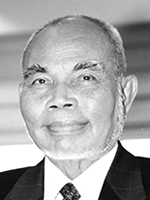Obayashi PrizeRecipient of the First Obayashi Prize
(2000)
Mr.Vann MOLYVANNPresident and Executive Director of the APSARA Authority (Authority for the Protection and the Management of Angkor and the Region of Siem Reap) and Minister of State and Senior Advisor to the Royal Cambodian Government (at the time of receiving the prize)

| 1926 | Born in Cambodia; after completing secondary and higher education in Phnom Penh, moves to France to pursue further studies |
|---|---|
| 1956 | After returning to Cambodia, holds positions such as Chief Architect for State Buildings and Director for Urban Planning and Habitat |
| 1962 | Becomes Secretary of State for Public Works and Telecommunications |
| 1965 | Becomes President of the Royal University of Fine Arts |
| 1967 | Becomes Minister for National Education and Fine Arts |
After the end of the war in Cambodia that started in 1970 and lasted for more than 20 years, Mr. Molyvann became involved in urban planning and urban renewal in 1991. He has been devoting his energies to the preservation and restoration of the Angkor monuments. Mr. Molyvann has been awarded numerous honors including the "Ordre Royal du Cambodge" and the French order "Communandeur de la Legion d'Honneur."
Reason for receiving the prize
As an architect and a senior government official of Cambodia, Mr. Molyvann has been involved in urban planning and renewal, in addition to the construction of numerous public facilities. Among the leading landmarks that he has designed are the Independence Monument, the State Guest House at Chamcar Mon, the Chakdomuk conference hall, and the Council of Ministers Building. Mr. Molyvann has also worked on numerous urban development programs in Asian and African countries, including the development of the site and surroundings of the National Olympic Stadium and Sports Complex and the master plan for the urban renewal of Phnom Penh. He has a remarkable track record in this field.
Mr. Molyvann believes that, as part of effort for recovery from the ravages of the long war, restoration of cultural monuments and utilization thereof for enhancing urban functions would lead to the revival of Cambodia as a tourist and cultural destination. He has spent much time devoting himself to the preservation and restoration of the Angkor monuments. Through such activities, Mr. Molyvann has made enormous contributions to the restoration of World Heritage sites and the rebuilding of urban areas.


